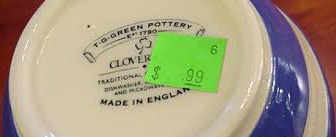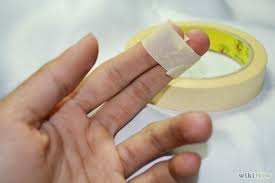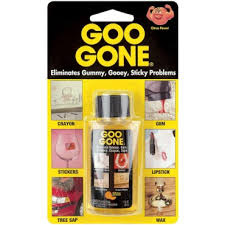Preserving It
Once you acquire a collectible toy or a piece of art you become its custodian which makes you responsible for its well being. Preserving it should be part of the joy of collecting not a burden. Often we hide our treasures away thinking we are protecting them and then years later open to find them a mess. Now this goes against my first rule to “enjoy your art and collectibles and display them”. There are some basic maintenance principles to apply and follow regardless if you are storing or displaying.
1. First remove any adhesive price tags as quickly as possible. The longer these are adhered the harder to remove unless you are willing to wait 20 or more years when the adhesive drys out and the tag falls off usually after marring the piece.
If you are able to peel that tag keep it and stick on your paperwork. A small piece of tape tapped on goo after label is pulled will often pull up the majority.
A quick wipe of Goo Gone or lotion and clean off the glue.
A inked tag may bleed thru the tag onto the art or collectible and stain it. If the seller marked the price in pencil, it may be left alone or erased. Above all, don’t write the purchase price on the item. Record keeping should be done in a notebook or on your computer but never on the item itself. (The old fashion paper tag looped on works as long as the ink is away from item!)
2. Choose your storage container with care! Items sealed in plastic tubs cannot get dust but cannot get air either. If you insist on those big rubber tubs pierce some holes on end and glue fabric that breathes over the holes. Wood chests are great but harder to obtain and pricey. A good ol cardboard box in a dry area works. Mylar bags are recommended for acidic paper items such as comic books or magazines.
3. Artwork and cells should not be stacked in a way that creates pressure or the result may be paint cracks.
When framing use non acid mat and backs investing in a good archival framing will pay off in the future of the piece. Sometimes the wall is the best place to store so if you do not want displayed hang in a closet. Avoid Fluorescent lights which will fade all quickly. Extreme heat, and cold are really tough on collectibles so maybe that attic or storage shed is not the best choice.
4. 3D objects are best stored on shelves in closed cases to protect them from accumulating dust and particularly harmful tobacco smoke residue. Occasionally check items in case for dust and insects …it is a wonder how both sneak into even the best of cases.
5. Check your stored toys for even if well packed things like rotating rubber wheels so they don’t get flat spots, doll hair nets that are not on properly over time will cause goofy hairdos and sometimes just being in a box will cause problems. Mohair toys that look like they are loosing hair could be tiny mites inside! Seal toy in a large ziplock bag and place in freezer for a week if there are bugs you will see tiny black balls in bottom of bag.
6. Boxes- With shows like Antique Roadshow and ebay suddenly collectors are aware of the value of a box. Be careful you do not become a box collector … I tried breaking down doll boxes and after checking on stored boxes the condition has deteriorated so much that I should have just tossed. Remember most boxes were meant to protect the item thru a short journey in a retail store and were not made as long term storage. That cute little acetate window on the box will not hold up and your item will feel the grief.
Do nothing to degrade the item or art for it’s future value depends in part on the custodial care it receives from you.








